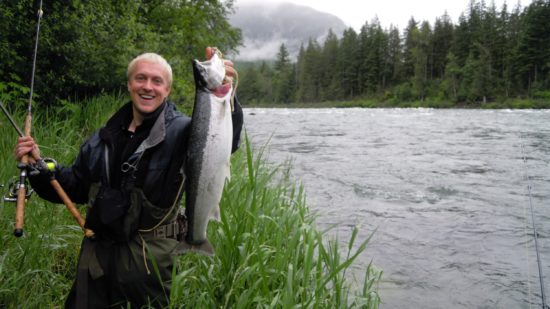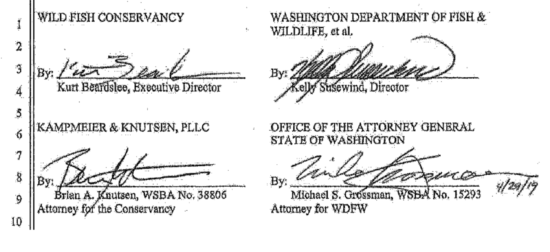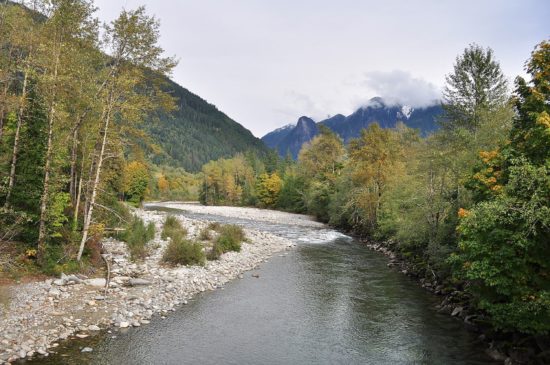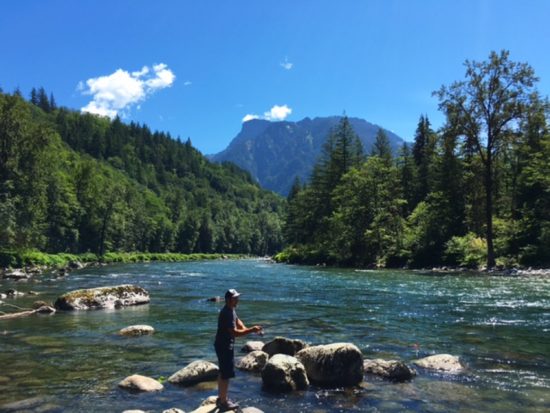
WDFW-WFC Settle Skykomish Summer Steelhead Lawsuit; State Plans New Broodstock Program
Editor’s note: Updated 2:35 p.m., May 3, 2019 with additional comments from WDFW
The hacking away at Puget Sound’s last consumptive steelhead opportunities as we’ve known them continues, though there’s also a glimmer of hope to save a popular fishery.
Releases of Skamania-strain summer-runs will be ended in the Skykomish River in the coming years following a lawsuit settlement between a highly litigious environmental group and state managers, who are also making a separate bid to replace the fish with locally adapted broodstock.

The deal reached in federal court this week allows WDFW to release 116,000 smolts this spring and next from Reiter Ponds, ensuring fair numbers of returning adults will be available for harvest in the popular river in the coming years, but drops that number to 60,000 and then 40,000 in 2021 and 2022.
Technically, the agreement with the Wild Fish Conservancy would allow the agency to continue to produce Skamanias in the Sky afterwards if the National Marine Fisheries Service provides ESA coverage for the hatchery program.
But in reality, the feds are the ones who have been pushing WDFW to stop releasing the out-of-basin fish in Puget Sound waters.
In a July 21, 2017 letter, NMFS Regional Administrator Barry Thom told then WDFW Director Jim Unsworth he should look for “alternative” stocks to hold fisheries over.
So afterwards the agency considered using steelhead from a tributary elsewhere in the Skykomish-Snoqualmie watershed for a long-shot broodstock replacement bid.
For a blog I did last June, that plan to use Tolt summers was described to me as the best hope to save the fishery.
But the consent decree signed in U.S. District Court for Western Washington in Seattle by WDFW Director Kelly Susewind and WFC’s Kurt Beardslee and their attorneys this week, and Judge James L. Robart yesterday, specifically bars using any fish out of the South Fork Tolt for the next eight years.

Yet in a twist, another option has since emerged.
WDFW and the Tulalip Tribes recently submitted a hatchery genetic management plan to use steelhead collected in the South Fork Skykomish instead — “a new path forward,” in the state’s words, and one that would seemingly secure the program from potential budget cuts being eyed coming out of the end of the legislative session.
It still needs NMFS’ buy-in, but those fish are a mix of wild and naturalized hatchery steelhead that since 1958 have returned to a fish trap at the base of the impassable 104-foot-tall Sunset Falls just east of Index and have been trucked upstream.
They have less Skamania heritage than those from the Tolt, according to a WDFW genetic analysis.
Last year, 348 summer-runs showed up at the falls, with the 221 unclipped fish released into the South Fork and the 127 clipped ones not allowed to pass.
Edward Eleazer, the state’s regional fisheries manager, says that that “pretty robust” population will help WDFW reach production goals a lot more quickly than if they had tried to pump redds for Tolt steelhead eggs, rear them at Tokul Creek Hatchery, and then transfer first-generation returning adults to Reiter to build up broodstock there, like was being considered last year.
The proposed HGMP calls for the release of 116,000 smolts reared from natural-origin parents annually, “providing important harvest opportunities primarily for recreational fisheries but also for treaty tribes.”
It’s a lifeline of hope for the last best summer steelhead fishery in Puget Sound.
“Once the South Fork broodstock is established, it should provide stable, reliable, and perhaps enhanced summer-run fishing on the Skykomish for the foreseeable future,” said Mark Spada, president of the Snohomish Sportsmen’s Club.

It could also spread out the fishery so we’re not all focused in the half mile of water at and below Reiter Ponds.
Spada said that under the HGMP, smolts could be scatter-planted into the Sky’s South and North Forks, and that that “could provide a lot of additional angling opportunity.”
Both stems of the Sky and their tribs are paralleled by state, county and logging roads.
“There are a lot more options to expand the fishery,” confirms Eleazer, who sounds pretty excited about it. “Now we can recycle fish. Before we weren’t allowed to … There’s a lot of river miles.”
He acknowledges that it all still does depend on NMFS approval, but says so far the feds haven’t expressed any negative comments or asked for more information on the proposal.
Eleazer says that where in the future fisheries will necessarily become more “surgical” and adaptive because of ESA constraints, that’s not the case in the waters above Sunset Falls.
He says that the program will also provide a “key tool in recovering that wild population” on the North Fork Skykomish.
It’s another testament to WDFW standing by the Sky and its importance to anglers.
“We know that transitioning to a local stock is better for fish, and that the Skykomish is a tremendously popular steelhead river,” said WDFW Director Kelly Susewind in a press release. “People will be able to continue enjoying the experience here much as they have in the past.”
The news is not as good for the river system to the north, however.
The WDFW-WFC court settlement essentially ends releases out of Whitehorse Ponds into the North Fork Stillaguamish with this year’s 90,000 Skamania smolts let go for return in 2021.
With an HGMP covering the stock, production could resume, but again, that seems unlikely with NMFS’ directive.
As the two parties moved towards a deal, members of the Steelhead Trout Club of Washington were warned they’d need to “really work hard” to save the Stilly program, which produces fish for one of the Westside’s rare fly fishing-only opportunities for hatchery summer-runs.
It wasn’t immediately clear if WDFW has any plans to develop a local broodstock on the Stillaguamish like it does on the Skykomish, but Director Susewind said he wanted to work with tribal comanagers to “explore alternative fishing opportunities.”
“While we never want to lose a fishery like the Stilly summer-runs, saving the Sky was the highest priority,” noted Spada.

Last February, when WFC announced it planned to sue the state within 60 days, the organization claimed that continued releases of Skamanias into Puget Sound streams represented a threat to ESA-listed steelhead, but the real strength of their argument was that WDFW didn’t have an HGMP to operate the programs.
That has been a problem for several years as NMFS’s collective desk has been buried with hatchery and fishery plans to approve, biops to write, sea lion removals on the Willamette to OK, etc.
That WDFW has settled yet again with WFC will deeply piss anglers off, but without that federal permit, the agency is highly vulnerable to the organization’s low-hanging-fruit lawsuit racket.
The settlement also includes a $23,000 check from WDFW to pay WFC’s legal fees and orders the state to perform five years’ worth of snorkel surveys in the North Fork Skykomish and South Fork Tolt to count fish.
That effort is estimated to cost a total of $400,000, a not insignificant amount considering the agency’s $7 million budget shortfall in the coming two years.

This is the second time in the past half decade that WFC has targeted WDFW hatchery steelhead operations on the Sky and elsewhere in Puget Sound.
In 2014, it was over early-returning Chambers Creek winter-runs, a Tacoma-area stock that has been used for decades.
That lawsuit resulted in continued releases into the Sky, but a pause elsewhere until WDFW had an HGMP in hand, the end of stocking in the Skagit for 12 years, and a $45,000 settlement check.
Prevented from releasing their fish, hatchery workers at Kendall Creek on the North Fork Nooksack and Whitehorse on the Stilly had to get creative to save the programs until federal ESA coverage came through, rearing their steelhead to adulthood at the facilities and spawning them there, as well as reconditioning kelts at the former.
This latest WFC lawsuit focuses on a 1950s mixture of Klickitat River and Washougal River steelhead that came from the hatchery on the latter stream and nicknamed Skamanias for the region of their origin.
They were once planted in numerous Puget Sound rivers, providing decades of good fishing on the Dungeness, Green, Skagit, Cascade, South Fork of the Stillaguamish, Canyon Creek, Sultan, North and South Forks of the Skykomish, Snoqualmie, Raging and Tolt.
But they also have a propensity for interbreeding with native fish and between that and the 2007 ESA listing of the region’s steelhead, they have been largely discontinued, leading to shrinking fishing opportunities and releases — from 190,000 into the Sky in 2015 to 116,000 in 2017.
That 2017 letter from NMFS’ Thom states that a WDFW researcher concluded “that genetic impacts to the two native summer steelhead populations in the Snohomish Basin have been so large that they are now considered feral populations of Skamania-stock fish.”
Now they may help keep steelheading going on the Skykomish if the feds approve the state and tribes’ plan.
“The potential risks of this hatchery program are minimal compared to the risks of failed steelhead habitat protection and restoration measures or adequately anticipating and addressing the effects of climate change,” the proposed HGMP states.

